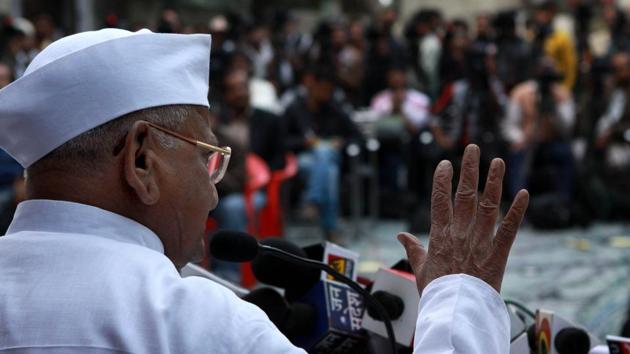The Anna and kisan movements, writes Rajdeep Sardesai
The Anna movement had the support of the media and middle-class and a clear enemy. The farm protests lack all three elements
One of the more ironic images from last week’s Bharat Bandh called by farmer groups was that of social activist Anna Hazare on a day-long fast in support of their demands. Accompanied by just a handful of supporters, a recorded message from his Ralegan Siddhi village was sent out to television channels. Most channels ignored it, a far cry from when multi-cam teams were chasing the then septuagenarian Gandhi topi leader, some even comparing him to a modern-day Mahatma.

The Anna moment in Indian politics has long gone. The question is: Can it be replicated by a new band of protesters and will the 2020 farm protests do to the Narendra Modi 2.0 government what the 2011 Anna anti-corruption movement did to Manmohan Singh’s second term?
There should be little doubt that the Anna movement was a catalyst in the decline and fall of the United Progressive Alliance (UPA) 2. It brought corruption to the political centrestage, crystallised public opinion against the government, enfeebled the executive, and paved the way for a Modi-like leader to offer himself as a strongman alternative to a tottering Congress-led coalition. The India Against Corruption grouping brought together a range of public figures from the Left and Right on the same platform, accompanied by the cry of sab neta chor hai (all political leaders are thieves).
Now, contrast the Anna movement with the farmers who have hit the streets. There is no Anna-like figure being held up as a mascot. Instead, we see are a multitude of farm union leaders, a majority of them from Punjab. The Opposition, with its own list of grievances against the Modi government, has also jumped in. If 2011 was Team Anna versus the Singh government, this is now being pitched as an Opposition versus Modi battle with farmers as foot soldiers.
But there is one key difference: There is no evidence yet of middle-class support. During the Anna movement, the middle-class instantly identified with the anti-corruption slogan. A series of scams created this connect between the protests and the growing sense of citizen anger and alienation towards the political class. That link is missing. India’s urban middle-class is perhaps the most vociferous constituency for free market reform. The idea that a farmer needs a safety net in a competitive market environment doesn’t seem to strike those who live in their consumerist nirvana.
A mass populist upsurge needs an identifiable enemy. The Anna movement had it in the imagery of Union ministers accused of corruption. The farmers protests are far more diffused: A demand for scrapping a law doesn’t create an immediate enemy figure. The farm leaders have attempted to whip up fury against corporate tycoons but whether allegations of cronyism will resonate widely is uncertain. Many Opposition parties have patronised these very business groups when they were in power.
There is another important difference. In 2011, the media was an active participant in shaping the anti-government narrative and elevating Team Anna leaders to national heroes. Now, compromised segments of the mainstream media are unwilling to challenge the government while routinely cornering the Opposition forces. The slew of Union ministers speaking out is a sign that the Modi government, unlike its predecessor, will not cede prime-time space for its opponents to set the agenda.
Maybe the basic difference lies in the persona of Modi and Singh. Where the latter was weakened by the rigors of coalition politics and his soft-spoken bureaucrat-politician image, Modi as the tough-talking authoritarian figure leading a majority government has less tolerance for any dissent. Where Singh rarely sat on prestige, the Modi approach is driven by the Supreme Leader’s conviction in his own sense of infallibility.
Unlike the Singh government which legitimised the Anna movement by setting up an official committee to discuss the anti-corruption Lokpal bill, the Modi government has attempted to divide and demonise the farmer protests with Union ministers claiming that there is a sinister design by the so-called “tukde tukde gang” of “urban Maoists” to infiltrate the movement. The incessant name-calling is a familiar stratagem used by the Modi machine in the past too. By invoking the K word — not kisan but Khalistan — the attempt is to convince the citizenry that these protests are not about farm reforms but actually about destabilising India. A Union minister has even bizarrely suggested that the protestors are acting on the instructions of Pakistan and China.
The farmers may have won the first round by forcing the Modi government to come to the negotiating table but don’t expect an intransigent Centre to blink so easily. This is not a government that will send its ministers to meet the farmers at the dharna site unlike the Singh government which inexplicably organised a red carpet ministerial airport reception for Baba Ramdev. Here, farmers have been barricaded, tear-gassed and highways dug up to prevent them from entering Delhi. A long winter of discontent lies ahead.
Post-script: For the urban middle-class, 2020 has been a wake-up call. The lockdown brought home the stark reality of despairing, poor urban migrants being forced to undertake the long walk back home. Now, the farm protests have at least ensured that the kisan and the rural economy seep into the national consciousness.




